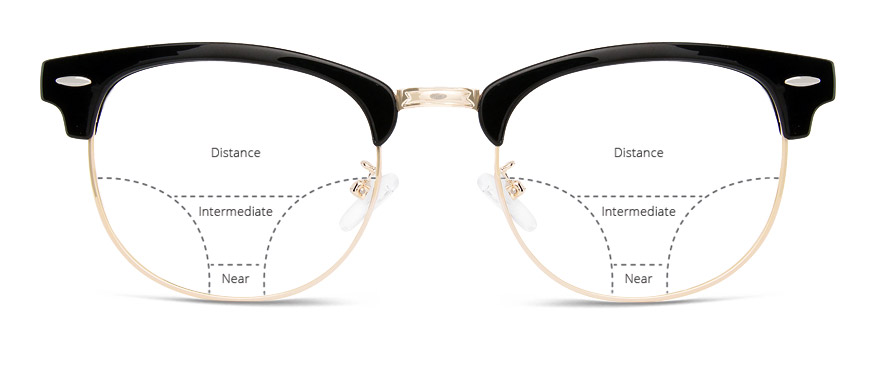Things about Progressive Multi-focus Lenses
Progressive multi-focus lenses are initially designed to provide a natural, convenient and comfortable correction for presbyopic patients, so that a pair of glasses can see distant, near and medium-range objects. Therefore, progressive lenses are also described as zoom lenses. Wearing one pair of progressive multi-focus glasses is equivalent to wearing multiple pairs of glasses.
If you ordered a pair of progressive multi-focus glasses from VlookOptical, which is very successful in optometry and wearing, it needs a certain adaptation period in the wearing process. Scientific understanding of this process can improve the wearing comfortableness and enjoy the scientific achievements better.
What is progressive lens?
Progressive multi-focus lenses are also called progressive lenses. As the name implies, a lens has multiple focal points. If the lens is divided by focus, it can be sorted to single focus lens, double focus lens and multi-focus lens. The most common lens is single-focus lenses, which has only one luminosity. Bifocal lenses are double-light lenses, which are used by many elder people to solve the problem of seeing far and near at the same time, but they have been basically eliminated because of their own major shortcomings and the gradual popularization of multi-focus.
Progressive lens is no-line multifocal eyeglass lens that looks exactly the same as single vision lens. Besides, progressive lenses will help you see clearly at all distances without those annoying (and age-defining) "bifocal lines" that are visible in regular bifocals and trifocals.
The power of progressive lenses changes gradually from point to point on the lens surface, providing the correct lens power for seeing objects clearly at any virtual distance.
Who are suitable for progressive multi-focus spectacles:
- Presbyopia people, especially those with far-sighted and near-sighted changes frequently;
- People who have high requirements for beauty and comfort;
- Persons who are not suitable for bifocal image;
- For people who are over 40 years age with myopia, presbyopia. People who are farsighted and nearsighted often need to take off their glasses or wear two pairs of glasses with different distant and near prescriptions.
- Teenagers or children with myopia need two pairs of glasses with different prescriptions of distance and proximity.
How to adapt to progressive multi-focus glasses for the first time?
- Far-sighted objects: Look up and look at the object through the top of the lens (far-sighted area).
- Near-sighted objects: Keep the head and horizontal plane about 45 degrees, so that the eyeball turns downward, through the lens below (near-sighted area) to see the object. If it is not very clear, slightly rotate the eyes or adjust the head position, raising the head position until you find the most ideal area to see near things.
Discomfort that may occur at your first wear:
- Slightly dizzy, walk shaky, go upstairs need to be careful when you are exercising.
- Spatial sensation changes, distance judgment and depth sensation of objects change. First wearers should not drive at once and not do strenuous exercise.
- When looking close, turn your eyes down, and your eyes will feel slightly uncomfortable.
- The object becomes blurred when you are looking through the blurred area of vision around the lens. Therefore, the first wearers should turn their heads more and eyeball less. Try to look at objects to the far, near and middle distance.
Items to be noticed in purchasing glasses:
When purchasing the glasses on VlookOptical, choose the frame with higher frame height. Lenses should be separated into far, middle and near areas, only higher frame can ensure a wide enough access area. It's better to have a full-rimmed frame for prescription glasses, because the higher lenses, the thicker the edges. And the full-rimmed frame groove can cover the thickness of the edge of the lens.
Generally it takes about a week to adapt to the glasses, different person has different adaption period. Walking slower when dizziness occurs.
Since the astigmatism region on both sides of the lens, it is not clear to see the objects on both sides when just turning your eyeballs through light, so it is necessary to rotate the neck and eyeballs at the same time to see clearly.
When you go downstairs, keep glasses stay low and try to look objects from the upper remote area.










